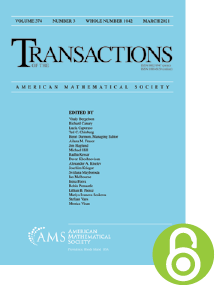A problem of Foldes and Puri on the Wiener process
HTML articles powered by AMS MathViewer
- by Z. Shi PDF
- Trans. Amer. Math. Soc. 348 (1996), 219-228 Request permission
Abstract:
Let $W$ be a real-valued Wiener process starting from 0, and $\tau (t)$ be the right-continuous inverse process of its local time at 0. Földes and Puri [3] raise the problem of studying the almost sure asymptotic behavior of $X(t)=\int _0^{\tau (t)} \mathbb {1}_{\{|W(u)| \le \alpha t\}}\,du$ as $t$ tends to infinity, i.e. they ask: how long does $W$ stay in a tube before “crossing very much” a given level? In this note, both limsup and liminf laws of the iterated logarithm are provided for $X$.References
- Albert Eagle, Series for all the roots of the equation $(z-a)^m=k(z-b)^n$, Amer. Math. Monthly 46 (1939), 425–428. MR 6, DOI 10.2307/2303037
- E. Csáki, An integral test for the supremum of Wiener local time, Probab. Theory Related Fields 83 (1989), no. 1-2, 207–217. MR 1012499, DOI 10.1007/BF00333148
- Antónia Földes and Madan L. Puri, The time spent by the Wiener process in a narrow tube before leaving a wide tube, Proc. Amer. Math. Soc. 117 (1993), no. 2, 529–536. MR 1116258, DOI 10.1090/S0002-9939-1993-1116258-6
- Jim Pitman and Marc Yor, A decomposition of Bessel bridges, Z. Wahrsch. Verw. Gebiete 59 (1982), no. 4, 425–457. MR 656509, DOI 10.1007/BF00532802
- Pál Révész, Random walk in random and nonrandom environments, World Scientific Publishing Co., Inc., Teaneck, NJ, 1990. MR 1082348, DOI 10.1142/1107 D. Revuz and M. Yor, Continuous Martingales and Brownian Motion, 2nd ed., Springer, Berlin, 1994.
- H. F. Trotter, A property of Brownian motion paths, Illinois J. Math. 2 (1958), 425–433. MR 96311, DOI 10.1215/ijm/1255454547
Additional Information
- Z. Shi
- Email: shi@ccr.jussieu.fr
- Received by editor(s): December 7, 1994
- © Copyright 1996 American Mathematical Society
- Journal: Trans. Amer. Math. Soc. 348 (1996), 219-228
- MSC (1991): Primary 60J65; Secondary 60G17
- DOI: https://doi.org/10.1090/S0002-9947-96-01485-7
- MathSciNet review: 1321589


